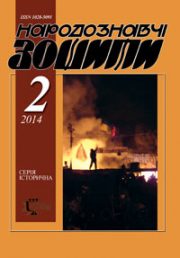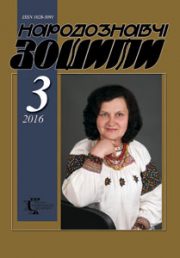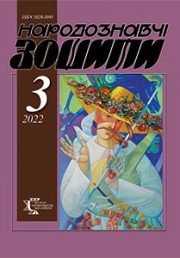The Ethnology Notebooks. 2019, № 4 (148), 944—950
УДК 398.8(=161.1):[271.4(477)-725:355]”18/19″(092)
DOI https://doi.org/10.15407/nz2019.04.944
SEMEN SPITZER: DUSHPASTER PATH AND FOLKLORISTIC INTERESTS
KRAVTSOVA Galina
ORCID ID: https://orcid.org/0000-0002-3774-1481
Candidate of Philology
Junior research folklore department
of the Institute of Ethnology of the National Academy
of Sciences of Ukraine,
15, Svobody ave., 79000, Lviv, Ukraine.
Contacts: е-mail: galynamagas@gmail.com
Abstract. The article reviews the priestly activities of Semen Spitzer, analyzes his folklore achievements, collected Ukrainian folk songs scrutinized genre variety of the handwritten collection and poetics of the presented works, their connection with the national tradition and local specificity.
Spitzer — a priest of the Ukrainian Greek Catholic Church, who served as part of the Austrian army, was a chaplain of the Ukrainian Sich Riflemen. After the service, he worked as a priest in the village of Solukiv, participated in propagation of national-patriotic ideas among the villagers. He belonged to the cohort of the Ukrainian intelligentsia, highly appreciated oral folk art and rooted for its preservation. In the Rylsky Institute of Art Studies, Folklore and Ethnology National Academy of Sciences of Ukraine has preserved a manuscript collection of songs recorded by S. Spitzer on the territory of his minor homeland. Withal, he used such scientific standards as pasportization, accuracy of the text, the preservation of dialects features.
It is noted that among the songs recorded by Spitzier, the greatest number of records are songs and ballads of soldiers. The first key themes are the themes of love, homeland, death. They are revealed through the appropriate motifs: «a girl throws a wreath on the water, a soldier tries to catch him», «a girl writes a letter to her beloved», «a soldier promises a girl to marry her», «the soldier forgets the mother’s will», «the soldier remembers the mother and asks for her forgiveness», «the soldier dies», «there is no one to bury the deceased», «the raven pecked out eyes of deceased soldier», «the soldier leaves the horse» and so on.
Collected ballads are variations of well-known songs about the poisoning of a son and daughter-in-law, the husband’s murder of the wife initiated by the mother, a “troysilla”, the villager murder by reason of a landowner girl love, a love spell of a man and his death as a consequence, etc.
The collection also contains samples of the family cycle, in which the key motifs are: «young people compete for a girl», «the husband does not love his wife», «the young wife being sad», and the socially domestic layer is «an orphan being sad because he has no family».
Keywords: priest, chaplain, folk art, poetics, motive.
Received 4.06.2019
REFERENCES
Marchuk, V. (2004). Church. Spirituality. Nation. Ivano-Frankivsk [in Ukrainian].
Shankovskiy, L. (1999). Ukrainskiy Galitskiy Armii: Military Historical Studio. Lviv [in Ukrainian].
Spitzer, S. (Ed.). Spivanki (without melodies). Historical, domestic, lullabies, zhovniki and another. Science Archive funds of manuscripts and audio recordings of the Rylsky Institute of Art Studies, Folklore and Ethnology. F. 28-3. Od. save 319 [in Ukrainian].
Spitzer, V. (2006). Тrails of the priest. Dzvin, 1, 98—103 [in Ukrainian].
Grinchishin, S. Semen Spitzer’s homeland served and still serves Ukraine. Retrieved from: http://www.voxpopuli.com.ua/storinkaavtora/spicervasil/rodinasemenaspicerasluzilaisluzitukraieni [in Ukrainian].
Kravtsova, G., & Sokil, V. (2018). Spitzer Semyon Stepanovych. Ukrainian folklore encyclopedia (Р. 773). Lviv [in Ukrainian].
Krynik, M. (2010). From the history of reading «Prosvytu» in Solukov village of Dolinskiy in district. Ukraine: cultural legacy, national consciousness, statehood (Issue 19, pp. 326—328) [in Ukrainian].
Hrushevskyi, M. (1993). History of Ukrainian literature: in 6 volumes, 9 books (Vol. 1). Kyiv [in Ukrainian].
Zhaivoronok, V. (2007). Mitology and speech world. Kyiv [in Ukrainian].
Usacheva, V., & Tolstoj, N. (Ed.). (1995). Pear. Slavic antiquities: ethnolinguistic dictionary: in 5 volumes (Vol. 1). Moscow [in Russian].
Kravtsova, G., & Pavliuk, S. (Ed.). (2015). Folk songs in the recordings of Hanna Bilinska: the genre palette, poetic ornamentation. The Ethnology Notebooks, 3, 725—732 [in Ukrainian].
Rozdolsky, O. (Ed.). Calendar rituals songs, historical, lyre, homelands, social domestic, kolomyiky. Science Archive funds of manuscripts and audio recordings of the Rylsky Institute of Art Studies, Folklore and Ethnology. F. 40-1. One save 26 [in Ukrainian].
Martiniv, I. (2005). Traditional folk songs of the village Khodovichi in the records of Evstahiy Dyuduk. Lviv [in Ukrainian].
Golubenko, І. (Ed.). (2000). Forest echo. Kyiv [in Ukrainian].
Sokil, V. & Sokil, H. (Eds.). (1998). Folklore materials from the fatherland. Lviv [in Ukrainian].
Ukrainka Lesya. (1977). Collected works: in 12 volumes (Vol. 9). Kyiv [in Ukrainian].
Fedkovich, Y. (1968). Folk songs of Bukovina in the records of Yuri Fedkovich. Kyiv [in Ukrainian].
Dey, O., & Yasenchuk, A. (1988). Baladi: Family Relations. Kyiv [in Ukrainian].
Tancyra, G. (Ed.). (1965). Yavdokhi Zuichi’s songs. Records of Gnat Tancyra. Kyiv [in Ukrainian].
Suprun-Yaremko, N. (Ed.). (2005). Ukrainian Kuban and their songs. Kyiv [in Ukrainian].
Agapkina, G., & Tolstoj, N. (Ed.). (1995). Intsest. Slavic antiquities: ethnolinguistic dictionary: in 5 volumes (Vol. 2). Moscow [in Russian].
Potebnja, A. (1883). Explanation of malorusia and similar folk songs (Vol. 1). Warsaw [in Russian].
Tolstaya, M., & Tolstoj, N. (Ed.). (2012). Рlow. Slavic antiquities: ethnolinguistic dictionary: in 5 volumes (Vol. 5). Moscow [in Russian].
Evarnitsky, D. (1906). Malorusia folk songs, collected by prof. D. Evarnitsky in 1878—1905. Ekaterinoslav [in Russian].






